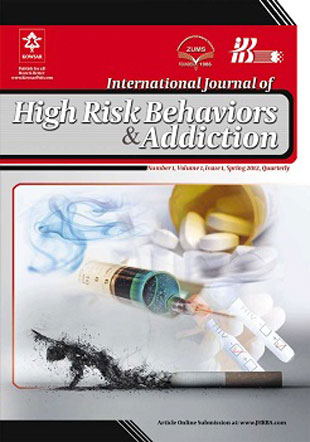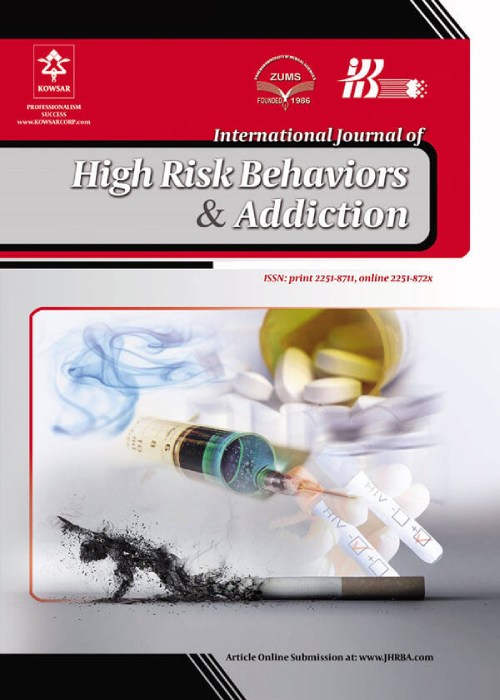فهرست مطالب

International Journal of High Risk Behaviors and Addiction
Volume:2 Issue: 2, Jun 2013
- تاریخ انتشار: 1392/07/01
- تعداد عناوین: 10
-
-
Pages 51-58BackgroundNow a days the utilization of Acceptance/Commitment and Emotion Regulation Strategy as a comprehensive treatment plan has been discussed in both the prevention and the control of destructive and risky behaviors. Treatment based on Acceptance/Commitment and Emotion Regulation was effective in both the improvement and the control of high-risk behaviors of students with dyscalculia..ObjectivesThe purpose of this study was to investigate the effectiveness of Acceptance and Commitment, and Emotional Regulation training in high-risk behaviors of students with dyscalculia..Materials And MethodsThis research was experimental, with pre-test, post-test and a control group. The statistical universe of this study included all sixth-grade male students in Ardebil city in the academic year of 1391-92 (A. H.). The subjects of this study involved 800 sixth-grade elementary students in Ardebil province, selected using a multi-stage cluster sampling. From among them, 60 students with dyscalculia were selected using random sampling method after the initial diagnosis by structured clinical interview and the Keymath Mathematic test. Twenty pupil were selected for either the experimental or the control group. To collect data, the questionnaires of «Keymath Mathematic test» and High-risk Behavior«were used..ResultThe results of Multivariate Analysis of Variance (MANOVA) showed that»Acceptance/Commitment and Emotion Regulation«treatment trainings were effective in reducing high-risk behaviors, in a manner that they led to a reduction in negative emotions, self-destructive and impulsive behaviors of students with math disorder (dyscalculia)..ConclusionsIt can be concluded that teaching these skills to the students has been influential in enhancing awareness level and change or positive attitude creation in the subjects. Therefore, it is essential to design and implement interventions based on»prevention caused by the peer group, in collaboration with the parents either at the school or at home among the family members«..Keywords: Acceptance, Commitment, Emotion regulation, High, risk behavior, Dyscalculia
-
Pages 59-65BackgroundChronic obstructive pulmonary disease (COPD) has been a major public health problem due to its high prevalence, morbidity, and mortality. Smoking is a major risk factor for COPD, while serious psychological distress (SPD) is prevalent among COPD patients. However, no study focusing on the effect of SPD on COPD has been so far conducted, while few studies have focused on the associations of SPD and behavioral factors with COPD by smoking status..ObjectivesThis study aimed to examine the associations of SPD and behavioral factors (such as smoking and physical activity) with COPD..Materials And MethodsWeighted logistic regression models were used for the analysis of 1,248 cases and 39,995 controls from the 2005 California Health Interview Survey (CHIS)..ResultsThe prevalence of SPD was 10% in cases and 4% in controls, respectively. The percentages of past and current smoking were higher in cases than controls (50% vs. 24% and 27% vs. 15%, respectively). After adjusting for other factors, smoking (OR=4.56, 95% CI=3.41-6.11 and OR=3.24, 95% CI=2.57-4.08 for current and past smoking, respectively), physical activity (OR=0.69, 95% CI=0.55-0.87), obesity (OR=1.25, 95% CI=1.03-1.52), older age (OR=2.86, 95% CI=2.15-3.82, and OR=5.97, 95% CI=4.42-8.08 for middle-aged, and elder groups, respectively), SPD (OR=2.11, 95% CI=1.47-3.04), employment (OR=0.62, 95% CI=0.51-0.76), race (OR=0.35, 95% CI=0.23-0.54, OR=0.59, 95% CI=0.36-0.97, and OR=0.47, 95% CI=0.29-0.75 for Latino, Asian and African American, respectively) and lower federal poverty level (OR=1.89, 95% CI=1.35-2.63, OR=1.65, 95% CI=1.27-2.14, and OR=1.39, 95% CI=1.12-1.72 for 0-99% FPL, 100-199% FPL and 200-299% FPL, respectively) were all associated with COPD (P < 0.05). Age group, SPD, race, and employment showed significant interactions with smoking status. Stratified by smoking status, aging was the only risk factor for COPD in the never smoking group; whereas, lack of physical activity, older age, SPD, race, unemployment, and lower federal poverty level were associated with COPD in the smoking groups..ConclusionsSmoking and aging were major risk factors for COPD, while lack of physical activity and SPD were strongly associated with COPD in the smoking groups..Keywords: Pulmonary Disease, Chronic Obstructive, Psychological Distress, Smoking, Physical Activity, Aging
-
Pages 66-71BackgroundA number of researches indicate that domestic violence (DV) causes abuse and vulnerability of women and children. Two components that can decrease violence and divorce are self-concept and self-differentiation..ObjectivesIn this research, we compare self-differentiation and self-concept in divorced and non-divorced women that experience domestic violence..Materials And MethodsTo achieve the goal of the research, 80 divorced women with domestic violence were chosen through available sampling and equalized with 80 non divorced women with domestic violence in aspect of age and education. They respond to instrument of self-differentiation (Skowron) and self-concept (Rodgers). Data was analyzed between the two groups using independent t-test. The significant level was (P < 0.01)..ResultThe findings indicated divorced women have more self-differentiation and self-concept than non-divorced women. In addition, there is a significant difference with respect to self-differentiation and self-concept in divorced and non-divorced women with domestic violence..ConclusionsThese results emphasize that self-differentiation and self-concept can be considered in premarital education (therapeutic interventions) to protective conditions against the occurrence of DV..Keywords: Domestic Violence, Self Concept, Divorce, Female
-
Pages 72-76BackgroundDrug abuse in juveniles is one of the most serious problems which lead to different physical, social and educational damages and outcomes..ObjectivesThe aim of the present study is to predict the addiction Potential in youths by their early maladaptive schemas..Materials And MethodsThe research sample included students of the University of Sistan and Baluchistan, Zahedan, Iran, with average age of 19-24 years. Participants were 260 undergraduate students (159 girls and 101 boys) that were selected by probability proportional cluster random sampling. The instruments were the Addiction Potential Scale (APS) and Early Maladaptive Schemas SQ-SF (short form questionnaires)..ResultsThe result showed that there are positive and significant relationships among early maladaptive schemas include Disconnection/ Rejection, Impaired autonomy / Performance, Impaired Limits, Other-Directedness and Over vigilance / Inhibition, and addiction Potential. Also, results of regression showed the highest Addiction Potential predicted by the following schemas: Disconnection / Rejection, impaired autonomy and performance other-Directedness..ConclusionsTherefore, Addiction Potential is one of the areas which can be used in planning and preventive activities, through identifying the groups with Early Maladaptive Schemas.Keywords: Behavior, Addictive, Adolescent
-
Pages 77-81Backgroundself immolation is a heinous way to commit suicide..ObjectivesThis study examined demographic characteristics and mental health in self immolation attempters in the city of Bandar Abbas.Materials And MethodsTwo groups are involved in this enquiry. A group of 30 participants who have committed self-immolation and the other consisting of 15 non-committers. To conduct the study, MMPI questionnaire of Minnesota was employed accompanied with demographic information and descriptive statistics as well as independent “T test”..ResultsThe research findings indicate that the self-immolation attempters were mostly among singles, females, low literates or illiterates, and housewives within the age group of 10-30 years old. According to the research there was a significant difference between the two groups regarding personality characteristics and records of hypochondriasis, depression, psychopathic deviation, and hysteria. However no significant difference was observed between the two groups regarding personality characteristics and paranoia, schizophrenia, psychasthrenia, and hypomania..ConclusionsSelf-immolation should be considered as an important mental health problem by the authorities. Moreover, the government should plan to make families more aware in order to prevent self-immolation and also help to recognize the risk factors in this area..Keywords: Self, immolation, Mental health, Demographic factors
-
Pages 82-86BackgroundStressful life events may cause initiation of drug use among people. The main purpose of this study was to evaluate the effectiveness of stress management skill training on depression, anxiety and stress levels in drug addicts after withdrawal..ObjectivesThe population included all drug addicts after withdrawal in 2012 on Alborz province..Materials And MethodsThe study was quasi-experimental with pretest-posttest design with a control group. Levels of emotional reactions (depression, anxiety and stress) in all referrals to a counseling center for drug withdrawal in 2012 using the Depression, Anxiety, Stress (DASS-21) questionnaire was assessed. The study population included drug addicts after withdrawal. The sampling method was available sampling and random assignment. 30 people who had higher emotional reactions were randomly selected and divided into two test (n=15) and control (n=15) groups. For the test group, a stress management skill training course was held in twelve 90-minute sessions, but the control group received no intervention. The obtained data were analyzed using SPSS19 software with analysis of covariance..ResultsThe results showed that stress management skill training has a significant effect on reducing emotional reactions (P< 0.01). It was noted that after 2 months test group follow-up, stress management training has retained its effect..ConclusionApparently, training addicts about life skills, particularly stress management seems to be a good idea..Keywords: Substance addiction, Anxiety, Depression, Stress, Psychological
-
Pages 87-91BackgroundQuality of life (QoL) stands for to the general well-being of the populations in the societies. Quality of life should not be confused with the concept of standard of living, which is based primarily on income. Instead, standard indicators of the QOL include not only wealth and employment, but also built environment, physical and mental health, education, recreation and leisure time and social belonging..ObjectivesThis study attempted to evaluate the QoL of the young addicted women compared to non-addict controls..Materials And MethodsThis case-control study was conducted on young addict women aged between 16-25 years old using with BREF-WHOQOL questionnaire. The subgroups included vulnerable addicts, non-vulnerable addicts and healthy controls..ResultsThe findings of the current study demonstrated that drug abuse led to reduce health-related QoL in all aspects of health compared with control group..ConclusionsHealth-related QoL was lower in all aspects of health compared with control group..Keywords: Young adult, Substance, Related disorders, Quality of Life, Vulnerability


